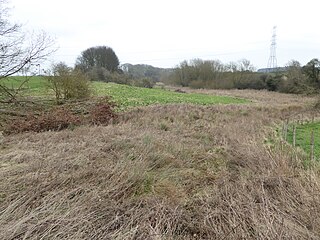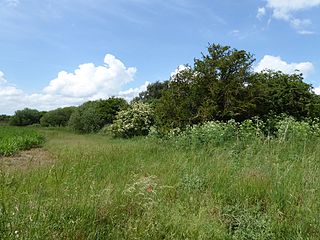
Blo' Norton and Thelnetham Fens are a 21.3 hectare biological Site of Special Scientific Interest (SSSI) on the Norfolk/Suffolk border. Blo' Norton Fen is in the parish of Blo' Norton in Norfolk and Thelnetham Fen is in Thelnetham parish in Suffolk. It is a Nature Conservation Review site, Grade 2, and part of the Waveney and Little Ouse Valley Fens Special Area of Conservation, Thelnetham Fen is managed by the Suffolk Wildlife Trust and Blo' Norton Fen by the Little Ouse Headwaters Project (LOHP).

Roydon Common is a 194.9-hectare (482-acre) biological Site of Special Scientific Interest east of King's Lynn in Norfolk. It is also a Grade I Nature Conservation Review site, a National Nature Reserve and a Ramsar site. It is part of the Roydon Common and Dersingham Bog Special Area of Conservation and Roydon Common and Grimston Warren nature reserve, which is managed by the Norfolk Wildlife Trust,

Castle Marshes is a 71 hectare nature reserve west of Lowestoft in Suffolk. It is managed by the Suffolk Wildlife Trust. It is part of the Barnby Broad and Marshes Site of Special Scientific Interest the Broadland Ramsar internationally important wetland site, the Broadland Special Protection Area under the European Union Directive on the Conservation of Wild Birds, and The Broads Special Area of Conservation.

St Neots Common is a 33.4 hectare biological Site of Special Scientific Interest in St Neots in Cambridgeshire.

Carlton Wood is a 10.4 hectare biological Site of Special Scientific Interest on the eastern boundary of Cambridgeshire, and west of Great Bradley in Suffolk.

Titchmarsh Meadow is a 2.2 hectare biological Site of Special Scientific Interest north-east of Titchmarsh in Northamptonshire.

Wadenhoe Marsh and Achurch Meadow is a 47.5 hectare biological Site of Special Scientific Interest south of Wadenhoe in Northamptonshire.

High Wood and Meadow is a 16.5 hectare biological Site of Special Scientific Interest between Farthingstone and Preston Capes in Northamptonshire. It is managed by the Wildlife Trust for Bedfordshire, Cambridgeshire and Northamptonshire.

Birch Spinney and Mawsley Marsh is a 12.3 hectare biological Site of Special Scientific Interest north-west of Broughton in Northamptonshire.

Southfield Farm Marsh is an 8.6 hectare biological Site of Special Scientific Interest in Kettering in Northamptonshire. An area of 2.8 hectares is managed as a nature reserve by the Wildlife Trust for Bedfordshire, Cambridgeshire and Northamptonshire.

Sprat's Water and Marshes, Carlton Colville is a 57.1 hectare biological Site of Special Scientific Interest on the western outskirts of Lowestoft in Suffolk, England. It is part of the Broadland Ramsar internationally important wetland site, and Special Protection Area under the European Union Directive on the Conservation of Wild Birds, and part of The Broads Special Area of Conservation. The northern part of the site is Carlton Marshes, which is part of Carlton and Oulton Marshes, a nature reserve managed by the Suffolk Wildlife Trust.

Lakenheath Poor's Fen is a 5.2-hectare biological Site of Special Scientific Interest west of Lakenheath in Suffolk.

Harby Hill Wood is a 16.9 hectare biological Site of Special Scientific Interest west of Eastwell in Leicestershire.

Empingham Marshy Meadows is a 14 hectare biological Site of Special Scientific Interest north of Empingham in Rutland.

Newton Burgoland Marshes is an 8.7 hectare biological Site of Special Scientific Interest east of Newton Burgoland in Leicestershire.

Misterton Marshes is a 6.8 hectare biological Site of Special Scientific Interest north of Misterton in Leicestershire.

Lockington Marshes is an 11.3 hectare biological Site of Special Scientific Interest north of Ratcliffe on Soar in Leicestershire.

Holwell Mouth is a 14.5 hectare biological Site of Special Scientific Interest south-east of Nether Broughton in Leicestershire. It is common land.

Leighfield Forest SSSI is an 11.3 hectares biological Site of Special Scientific Interest east of Skeffington in Leicestershire, England. It consists of several fragments, including Tugby Wood, Loddington Reddish, Brown's Wood, Skeffington Wood and Tilton Wood, of the former medieval hunting Leighfield Forest, which straddles Leicestershire and Rutland. It is a Nature Conservation Review site, Grade II.



















